How to Make Wonton Soup
Wonton soup is one of the heartiest Chinese comfort foods. It’s also a fantastic, healthy freezer meal for a whole family. Here’s a step-by-step guide to making wonton soup at home.
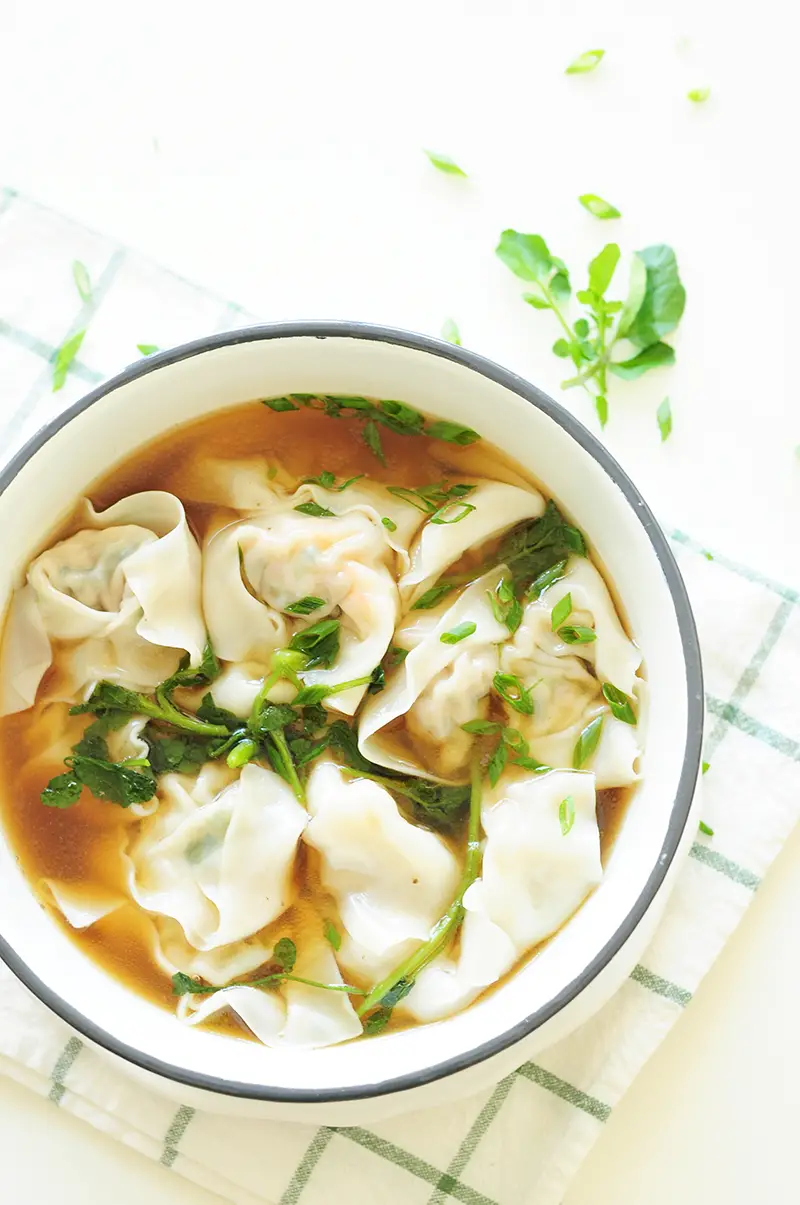
If you’ve had wonton soup in a Chinese restaurant and love it, but you are intimidated even by the thought of making it at home, don’t be. I am about to show you exactly how you can make a big batch of wontons at home and enjoy wonton soup whenever you want.
We are going to take it one step at a time. Sound good? Then follow along, please. This is going to level up your Chinese cooking, and it’s easier than you think.
HOW TO MAKE WONTON SOUP AT HOME
Step 1: Prepare the Filling: The Key to Making the Perfect Wonton Filling
The combinations of wonton fillings are literally endless. Depending on your preference, you can do all-meat fillings such as ground pork, ground chicken, or ground beef, all-vegetable fillings with shiitake mushrooms, or a mix of meat and vegetables, which is usually my choice.
Whatever you desire, remember this—the key to the perfect wonton filling is to keep it wet and sticky but not watery wet.
The consistency you are looking for in your wonton fillings is like a paste—firm enough to wrap but not dripping wet, which will destroy the wonton wrappers when folding.
With that said, it’s important to choose your vegetables for the filling wisely. Usually, the added condiments like soy sauce, Chinese wine, and oil in the wonton fillings do a fantastic job keeping all the ingredients together and giving you a juicy filling. But if the vegetable has a lot of water content, such as celery, zucchini, etc., it might generate additional liquid, which will make your filling too wet to wrap.
That doesn’t mean that you can’t use these vegetables with higher water content for wonton fillings. You just have to draw out the water from the vegetable with a bit of salt before mixing it into your filling.
In this post, I am going to share a classic wonton filling recipe using ground pork, watercress, shrimp, and fresh ginger along with salt, soy sauce, Shaoxing wine, olive oil, corn starch, and a tiny bit of brown sugar. These ingredients inject so many flavors into the filling! Trust me—your wontons are going to taste heavenly, even without the soup base.
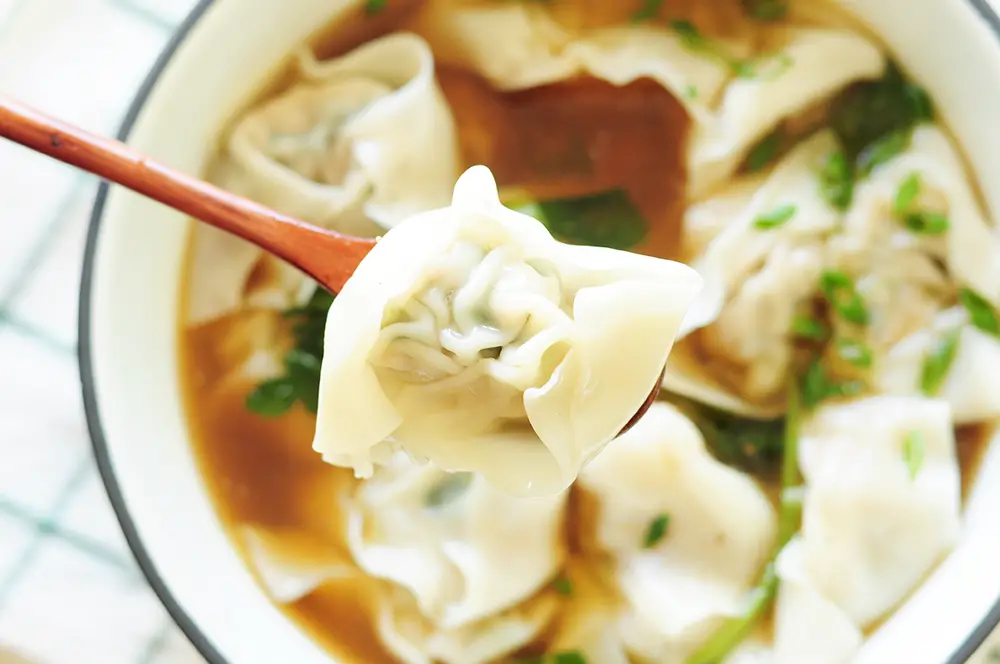
Step 2: Wrap the Wontons: How to Fold Wontons, Mom’s Way
Once your filling is ready to go, here comes the fun part—wrapping the wontons.
Have you ever folded wontons before? If so, you probably have your own way of wrapping them. No matter what shape of wontons you end up with, as long as the filling is securely sealed by the loose ends of the wrappers, you are in business.
For example, you could literally just put a scoop of filling in the middle of a wonton wrapper and fold it in half, then press the loose ends with your fingers. If your wonton wrapper is a bit dry to seal, dip your finger in water and wet the ends, then press to seal.
I learned wrapping wontons from my mom, who’s like a ninja in this kind of stuff. I got a chance to film her wrapping wontons the other day. So here comes a mini cooking lesson from the master chef, if you’d like to learn how it’s done in my street-smart kitchen.
- Take one wrapper and lay it on the palm of one hand, the narrow side facing you. Scoop up about 1 tablespoon pork filling and place in the center of the wonton wrapper. Add a piece of shrimp on top.
- Lift the narrow side of the wrapper and fold towards the wide side, covering the filling completely. The narrow side should go up to the point where there’s about a half-inch left to the wide side.
- Slightly dip your thumb into the water. Use your fingers to pinch the narrow- and wide-side edges of the wrappers together around the filling, then bend the wonton into a nurse’s hat, using your wet thumb to press the two ends together. When you are done, the wide side will stand up higher than the filling-stuffed narrow side.
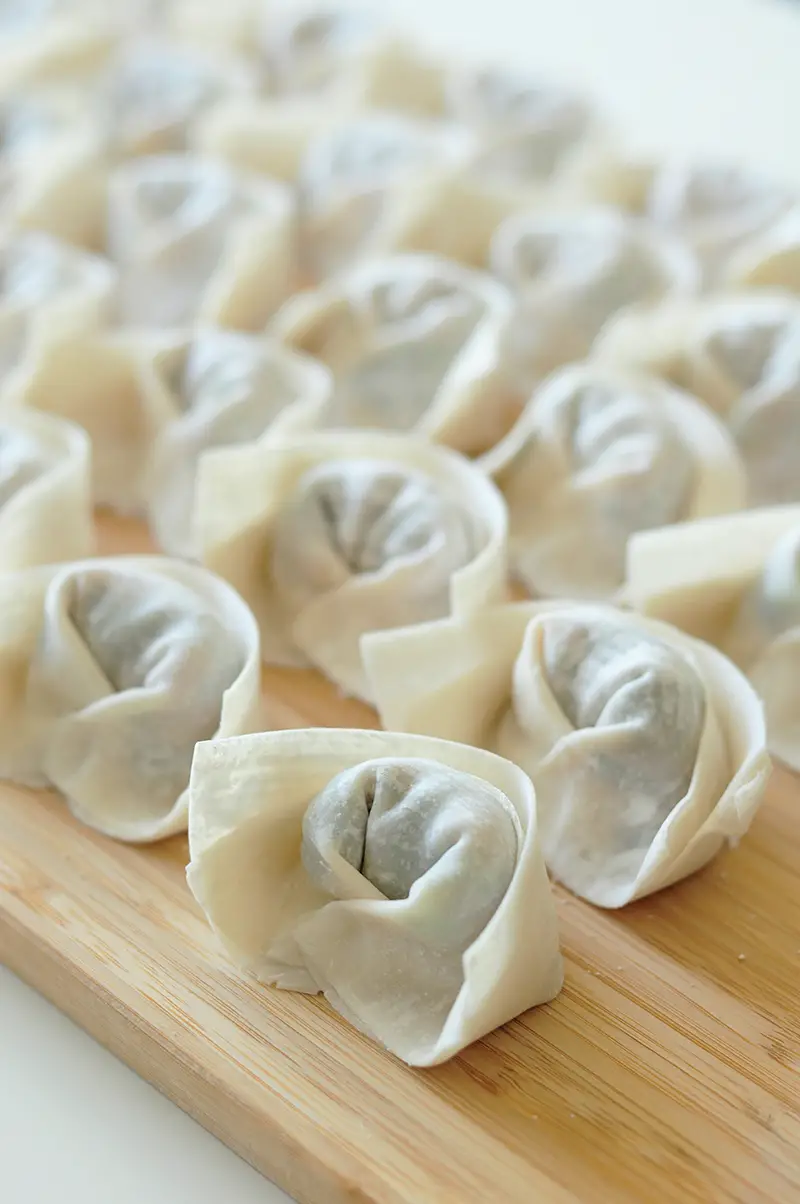
Step 3: Make the Wonton Soup Base
When making wonton soup, the wontons and the soup base are usually cooked separately. It’s because the cooking liquid from the wontons is typically a little too starchy to use as the soup base. It also has a flourish taste, which many people find unpleasant.
There are a few ways to make a delicious wonton soup base.
- Seasoned water. Hot water along with soy sauce and sesame oil is the most basic soup base you can put together for your wonton soup. To add more umami flavor, prepare some chopped green onions, dried mini shrimp, and seaweed in a large bowl, then pour the seasoned water over. Tada!
- Chicken flavored soup base. You can use chicken bouillon with water or straight-up chicken broth or chicken stock to flavor up the soup base. Add some light soy sauce and ginger, and drizzle with sesame oil to finish it.
- Bone broth soup base. Bone broth is by far my number one choice for any soup. Not only because of its rich and dense flavor but also because of its high content of collagen, amino acids, and many more essential nutrients that we need for our health. This wonton soup recipe uses Kettle & Fire Chicken Bone Broth lightly flavored with salt and pepper, along with a little bit of watercress and chopped green onion. In my opinion, there’s no need to add additional condiments or other ingredients if you have bone broth on hand. But of course, feel free to add light soy sauce, ginger, seaweed, dried mini shrimp, and sesame oil if you desire to make your soup base super duper umami.
Pro tip: If using dried ingredients like dried shrimp and seaweed, divide them into single-serving portions and place each portion in a serving bowl first, then pour the hot soup base over. Don’t fill up the bowl just yet; leave room for your wontons.
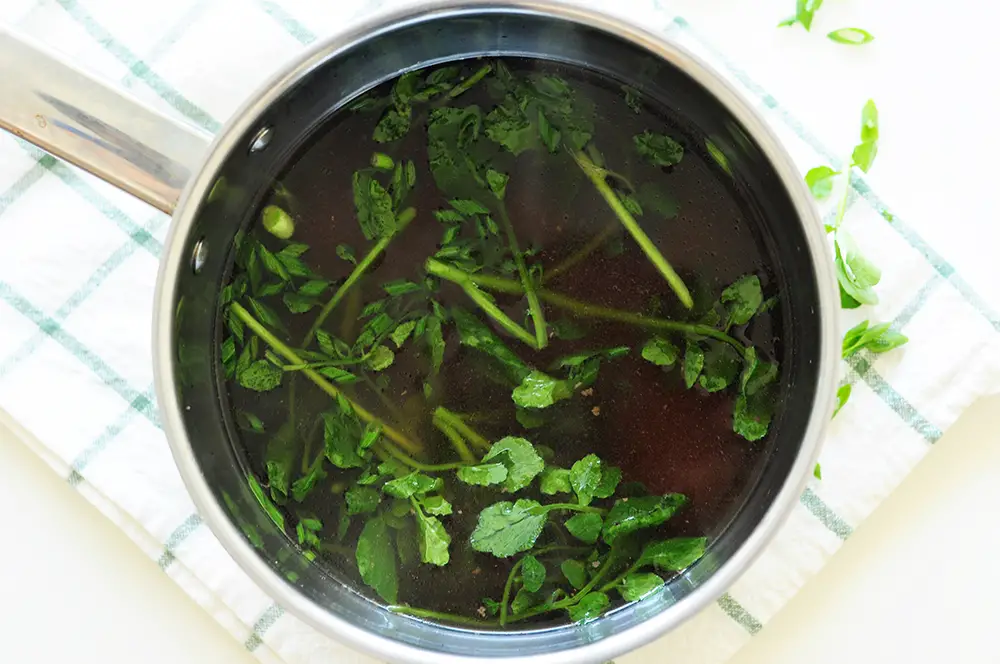
Step 4: Cook the Wontons
The best-tasting wontons are obviously freshly wrapped ones. But wontons also freeze easily.
If your wontons are freshly wrapped, all you need to do is bring a pot of water to a boil and add them to the boiling water. Don’t overcrowd the wontons in the pot; you don’t want them to stick together. Once all the wontons float to the top, they are done. The wonton skins should look semi-transparent. Depending on the size of your wontons, the regular big ones typically take about 5 minutes to cook.
If your wontons are frozen, you don’t need to thaw them before cooking. Throw the frozen wontons in a pot of boiling water just as you do with fresh wontons. Let them cook for about 3 minutes, and add a cup or two of cold water. Bring it to a boil again, then cook until all the wontons are floating. Frozen wontons usually take about 7-10 minutes to cook through.
If you are making a pot of hearty soup loaded with vegetables and other goodies, and you want to throw in a few wontons directly in the soup, by all means, do it. No need to cook the wontons separately if you want to save some time.
Pro tip: You can make the wonton soup base and cook the wontons simultaneously on two different burners on the stove to save time.
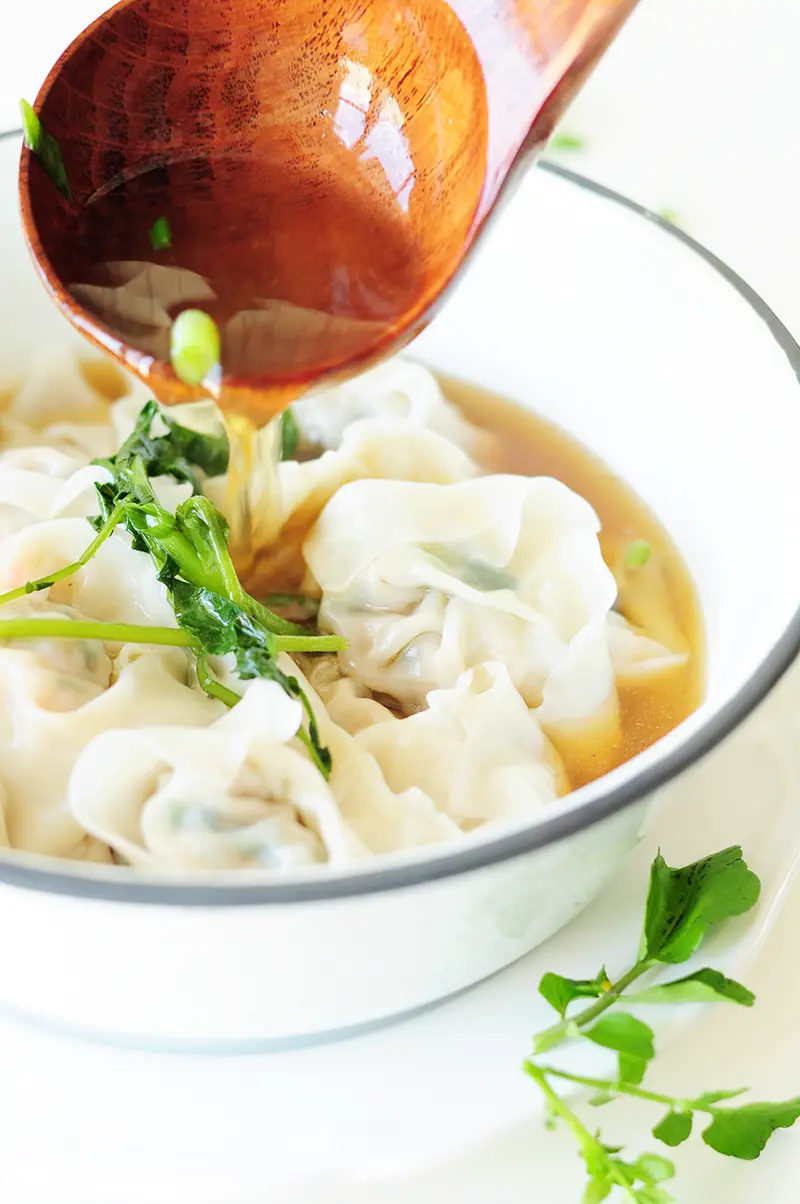
Step 5: Assemble the Wonton Soup
Now that you’ve got the wonton soup base and cooked wontons ready, time to put everything together.
Scoop up 10-12 large wontons as one serving using a large slotted spoon and carefully place them in the serving bowl that contains the prepared soup base. Gently stir and sprinkle with freshly ground black pepper.
If you like spicy like I do, give your wonton soup a kick by drizzling some homemade hot chili oil. Trust me, it totally hits the spot!
OTHER COOKING TIPS
How Much Filling Should I Put in One Wrapper?
It depends on the size of your wonton wrapper. The majority of the wonton wrappers in Asian grocery stores are about 3.5”x3.5”. For that size, 1-1.5 tablespoons of filling is a good amount.
The rule of thumb here is to have enough room left on the edge of a wonton wrapper to securely seal the filling inside after folding.
- If the filling gets easily squeezed out of the edge of a wonton wrapper, it means you put too much filling in it. The wrapper won’t seal well, which will cause the wonton to fall apart when cooking.
- If your wonton can’t stand up after folding, it probably means that you’ve put too little filling in it, which isn’t a deal-breaker, but we want a satisfying bite from each wonton, don’t we? So don’t be too afraid of adding the filling. You can always remove some if it’s too much.
How to Properly Place the Wrapped Wontons
Say that you are ready to wrap some awesome wontons. Before you do so, make sure to dust your work surface with some flour to prevent the bottom of your wontons from sticking on the surface.
You also want to keep some distance between each wonton to prevent them from sticking to each other.
The store-bought wonton wrappers are normally dry, but remember, we dip our big thumb in water to seal the wontons when wrapping. If the water accidentally gets on the bottom or other parts of the surface of your wontons, they’ll likely stick. It’ll be difficult to pick them up without breaking them. Therefore, better to be careful with the water.
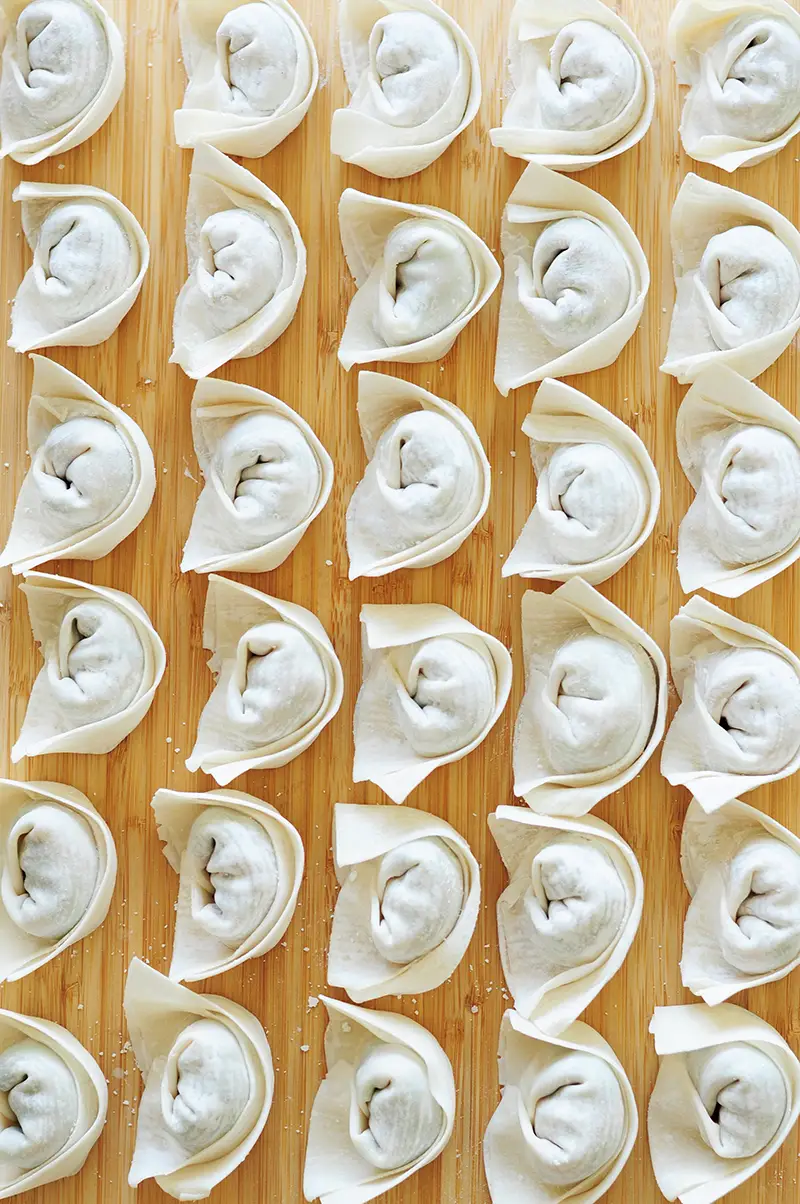
How to Freeze and Store Wontons
If you are like me, you probably want to wrap a big batch of wontons and keep some for later use. To properly store wontons, here are some simple steps to follow.
- Make sure to lay the freshly wrapped ones in a single layer with a little room between each one on a baking sheet, big plates, or anything with a flat surface that can fit into your freezer.
- Cover with plastic wrap and freeze for an hour or so until the wontons are frozen.
- Now you can transfer the wontons into containers or large Ziploc bags. Then put them back into the freezer to enjoy later. I recommend that you divide them into single serving sizes to store. That way, you know that one container or one bag is for one person.
Why Do My Wontons Fall Apart During Cooking?
If you see your wonton fillings escaping from the wrappers, there are a couple of possible reasons.
- You cooked your wontons for too long.
- Your wontons didn’t seal well when you wrapped them.
How Much Soup Base Should I Use for One Serving of Wontons?
- For serving wontons as an appetizer (5-6 wontons), prepare 1 cup of soup base.
- For serving wontons as a main course (10-12 wontons per serving), prepare 2 cups of soup base.
- You get the idea. Basically, 1 cup of soup base for each 5-6 wontons.
That’s pretty much all you need to know about how to make a classic bowl of homemade wonton soup. I truly hope this guide is helpful. As always, please share your thoughts in the comments below when you get a chance to make it. Or, share a photo of your delicious wonton soup on social media and tag #streetsmartkitchen so that I can see it.
Happy wonton making!
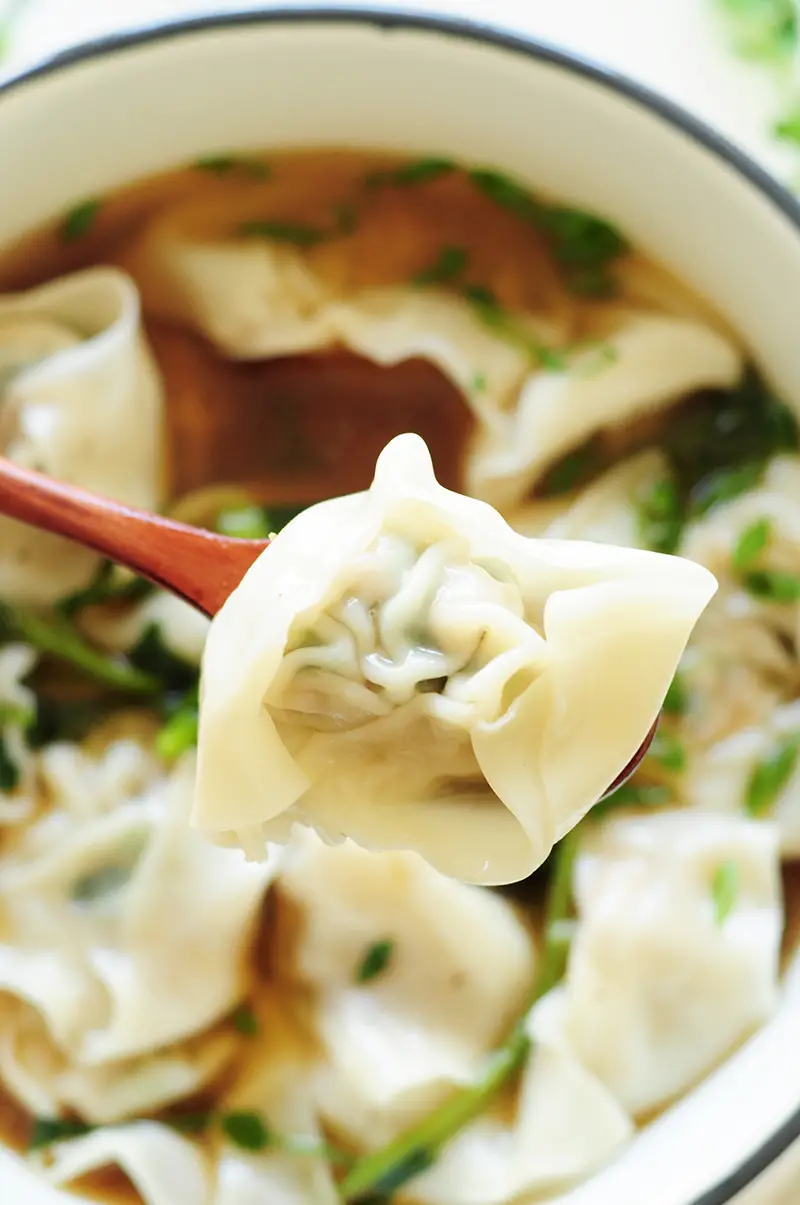
Classic Wonton Soup Recipe
Hearty wonton soup made with a classic ground pork and shrimp filling. With chicken bone broth as its base, it’s uber healthy and flavorful. It’s also a fantastic, healthy freezer meal for a whole family.
- Prep Time: 30 minutes
- Cook Time: 10 minutes
- Total Time: 40 minutes
- Yield: 4 servings
- Category: Main, Soup, Cooking Tips
- Method: Stove
- Cuisine: Chinese
Ingredients
- 40 large wonton wrappers
For the wonton filling – shrimp:
- 20 medium-sized shrimp, peeled and deveined, cut into half lengthwise
- 1/2 teaspoon kosher salt
- 1/2 teaspoon cornstarch
- 1 teaspoon extra-virgin olive oil
For the wonton filling – pork:
- 1 pound 80% lean ground pork
- 1 1/2 tablespoons fresh ginger, minced
- 1 tablespoon Shaoxing rice wine
- 2 tablespoons light soy sauce
- 2 teaspoons cornstarch
- 1 teaspoon brown sugar
- 2 tablespoons extra-virgin olive oil
- 1/2 teaspoon kosher salt, divided
- 6 ounces watercress, chopped (about 4 cups)
For the wonton soup base:
- 8 cups (4 cartons) Kettle & Fire Chicken Bone Broth or homemade chicken bone broth
- 2 cups of watercress or other desired green vegetables (optional)
- Salt and pepper to taste
- Chopped green onion for garnishing
- Hot chili oil or sesame oil for drizzling (optional)
Instructions
- Combine the shrimp filling ingredients in a small bowl and mix well. Set aside.
- Combine pork, ginger, Shaoxing wine, light soy sauce, cornstarch, and sugar in a big mixing bowl. Stir well.
- Add olive oil, salt, watercress in the pork mixture. Use both of your hands to mix all ingredients together.
- Prepare a flat work surface by dusting with a little flour. Spread it out with your hand. Prepare a small bowl of water on the side.
- Now wrap the wontons. Lay one wrapper flat on your palm of one hand, the narrow side facing you. Scoop up about 1 tablespoon pork filling and place in the center of the wonton wrapper. Add a piece of shrimp on top.
- Lift the narrow side of the wrapper and fold towards the wide side of the wrapper, covering the filling completely. The narrow side should go up to the point where there’s about half-inch room left to the wide side.
- Slightly dip your thumb into the water. Use your fingers to pinch the narrow- and wide-side edges of the wrappers together around the filling, then bend the wonton into the shape of a nurse’s hat, using your wet thumb to press the two ends together.
- Repeat with the rest of the wrappers and place the wontons on the working surface in one single layer with a little distance between each one.
- Bring a large pot of water to a boil, add the number of wontons that you want to cook. Let them boil for about 5 minutes until they float. Taste one to see if the filling is cooked through.
- At the same time, bring chicken bone broth (2 cups for 10-12 wontons) to a boil in another pot. Add some watercress or your desired green vegetables, like baby bok choy. Cook until the vegetables are wilted, about 1-2 minutes. Season with salt and pepper to taste.
- Transfer the soup base to a serving bowl, and drop the cooked wontons into the bowl using a slotted spoon. Garnish with chopped green onions and drizzle with hot chili oil or sesame oil if desired. Enjoy!
Notes
- Halve the shrimps (instead of using them whole in the filling) so the filling will cook through easily. It’s easier to work them with while wrapping the wontons, as well.
- Alternatively, you could cook some noodles together with your wontons, drain the noodles and wontons well, and transfer them to the prepared wonton soup base. That is a delicious bowl of wonton noodle soup, my friend!
Nutrition
- Serving Size: 1
- Calories: 494
- Sugar: 1.3g
- Sodium: 1483.1mg
- Fat: 11.2g
- Saturated Fat: 1.5g
- Carbohydrates: 51.3g
- Fiber: 1.7g
- Protein: 47.9g
- Cholesterol: 245.3mg
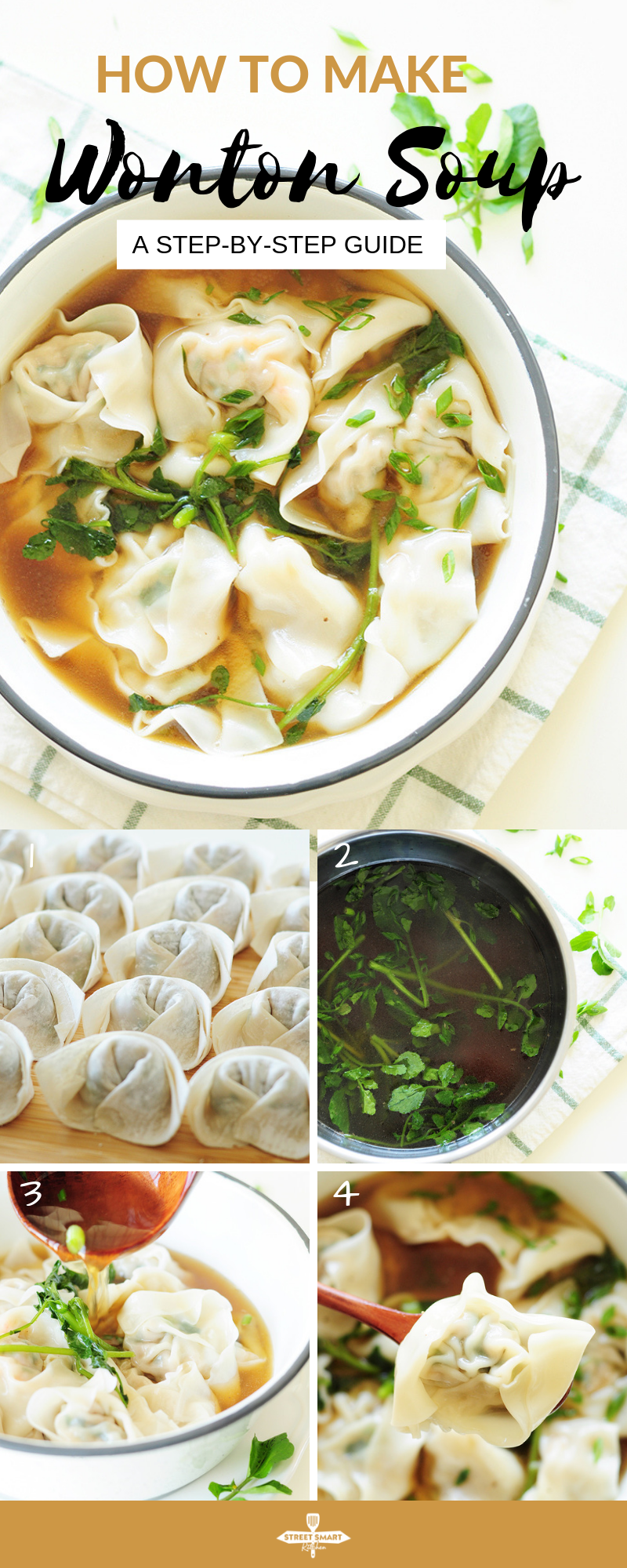
About the Author
Sharon Chen is an Integrative Nutrition Health Coach and author of the Complete Sous Vide Cookbook. She believes food not only brings healing but also connection. As the creator of StreetSmart Kitchen, she aims to make meal prep easier than ever and help you find balance, ease, joy, and simplicity in the kitchen as you improve your well-being.


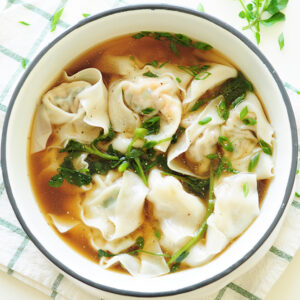

This is one of my favorite soup!! You have explained it so well.. definitely trying it this weekend
Thank you! I hope it works out for you. Let me know if you have any questions. 🙂
I have to admit I never tried wonton soup but by the look and how it sounds now I definitely need to make this. It has so much flavors that I just love. I’m saving this and will give this a try. Just beautiful soup.
I never thought to make homemade wontons, but after reading this I for sure want to give it a try!
Looks so delicious, hearty and comforting! I love wonton soup!
This Wonton Soup looks so amazing! This is perfect for the chilly days!
Thanks for sharing all the great tips on how to make this soup. Looks delicious and a fun recipe to try making at home.